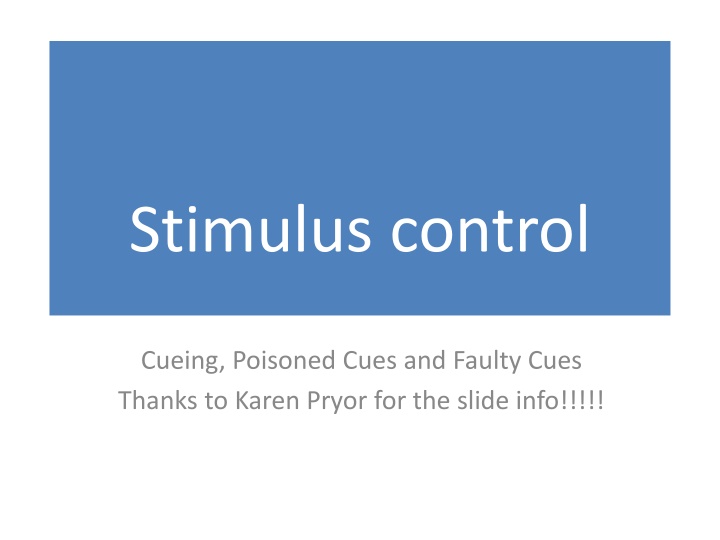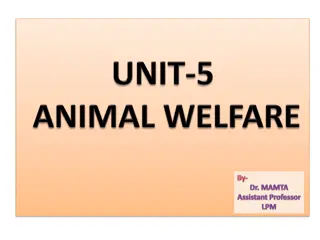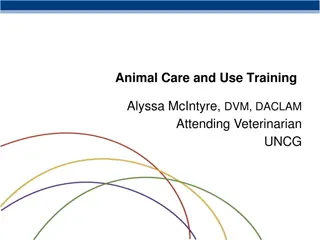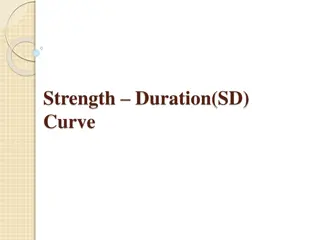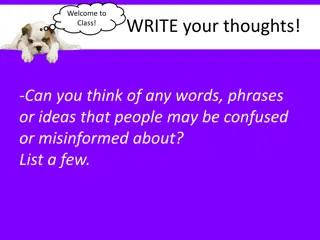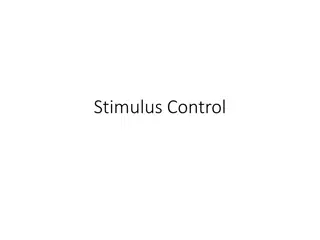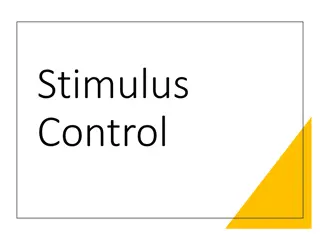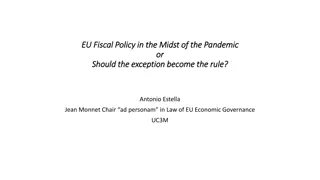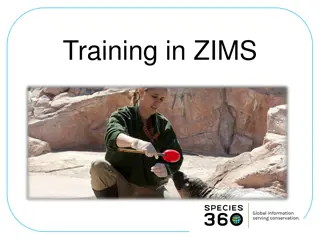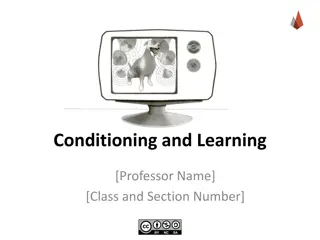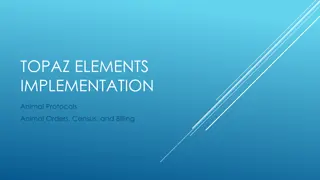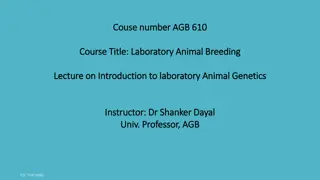Stimulus Control in Animal Training
Dive into the concept of stimulus control, distinguish between cues and commands, and learn the basics of cueing effectively in animal training. Explore the importance of trailer loading in horse behavior studies.
Download Presentation

Please find below an Image/Link to download the presentation.
The content on the website is provided AS IS for your information and personal use only. It may not be sold, licensed, or shared on other websites without obtaining consent from the author.If you encounter any issues during the download, it is possible that the publisher has removed the file from their server.
You are allowed to download the files provided on this website for personal or commercial use, subject to the condition that they are used lawfully. All files are the property of their respective owners.
The content on the website is provided AS IS for your information and personal use only. It may not be sold, licensed, or shared on other websites without obtaining consent from the author.
E N D
Presentation Transcript
Stimulus control Cueing, Poisoned Cues and Faulty Cues Thanks to Karen Pryor for the slide info!!!!!
Why do we use cue and not command ? Okay partially because it is PC BUT: meaning behind it Cue or Command suggests requiring or forcing dog to do something Command? Cue is a term that cues the animal. Suggests animal has a choice Fits in with LIMA programs
A cue is like a green light Tells the animal that it has an opportunity to earn reinforcement How? By performing the behavior that is associated with the cue. Cueing Basics There are five criteria for an effective cue. The cue should be: 1. Easy to give consistently 2. Easily perceived by the animal 3. Not confused with praise or other meanings 4. Distinct from other cues the animal already knows 5. Easy to transfer to others
A fluent cue response is: Precise: animal performs the behavior exactly as you had envisioned Performed with low latency Performed with optimal speed Shows resistant to distraction Performed at any distance from the handler Performed for the duration required by the handler Cueing Basics:
A cue is properly trained when It meets the conditions for fluency, and When the criteria for stimulus control are met. Criteria for fluency are: The animal Performs the behavior when it perceives the cue. Cueing Basics No longer offers the behavior in the absence of the cue. Does not perform the behavior in response to some other cue. Does not perform some other behavior when it perceives he cue.
Trailer loading = critical horse behavior Horses often not like trailers Small, dark, confined Aversive methods often (usually) used Too much negative reinforcement and punishment, which often escalates to increasingly aversive treatment Ferguson and Rosalez- Ruiz (2001)
Back up Move Forward Turn left/right Step up Horse Loading Behaviors Loading problems = leading problems Horse not going where led Balks, turns away, etc.
5 horses with poor loading history 2-horse straight load step-up trailer Butt chain instead of butt bar Side windows and rear doors left open White inside and outside Railroad tie used as extension of trailer deck Method Target: Red pot holder Reinforcers = typical horse treats 15 min training sessions
Baseline compared to training Loading behavior chain: horse approach trailer: 1. Within 3 meters (about 10 feet) 2. Within 1.5 meters 3. With head/neck in trailer 4. With front legs in trailer 5. With body in trailer 6. With 3 legs in trailer 7. With 4 legs in trailer; less than 5 sec 8. 4 legs in, allowed butt chain to be fastened, door to be closed. Method
Inappropriate responses/stress responses: Amount of horse in trailer (using 8 step chain) Freezing Head toss Standing Turning Loading: Getting into trailer (less than 5 sec) Loading and staying in trailer Behaviors Recorded: Number of prompts New leads (re-approaches) Latency to respond to cue: Within 5 sec Greater than 5 sec No response Also obtained interobserver agreement (IOA)
Baseline: 1 day of repeated 5 min baselines Target training: 2 days; 20-30 trials/day Touch target Criteria: 80% of prompts Trailer training: Trials to touch (just inside trailer) Upon entry, lead back to start and another trial Started at each horse s baseline distance Procedure: Added then faded trailer extension Trained to load on left/right sides Added limited hold with Fancy: gave several steps to move forward Multiple baseline design across horses
Results All horses learned to target during first training session First session: average of about 60% accuracy Second session: average of 80% Sammy took 3 sessions, but reached 90%
Baseline: no horse able to get beyond step 4 (front legs in trailer) After initial target training: Range of step 6 to step 8 (3 to 4 legs in trailer) All horses able to be loaded Fancy: 5 to 6 mastered When added extension: all but Fancy reached criterion performance Fancy outwitted researchers: could stretch to touch target even with extension Had to add the limited hold condition to outwit him.
Combined horse data All horses maintained loading behaviors when extension removed Loading left and right and new trailers produced some disruption but quickly recovered All reached 90%
Inappropriate Responses Most common: Standing Turning Head toss Immediately decreased with training Note: not targeted Suggests these are stress responses
Leads and Prompts During baseline: Few leads and LOTS of prompts During training: Fewer prompts Leads were about 1:1 with prompts
Target training decreased inappropriate responses secondary to increasing trailer loading Summary: Target Training Target training established stimulus control This allowed stimulus control during situations which usually elicited problem behaviors Horses so busy focusing on target that they ignored poisoned cues
Avoids learned helplessness Dogs learn to move or do something else to get a reward when NOT clicked With punishment for inappropriate response, dog learns to not move Gives organism control over the environment Opposite of LH, where learn that their behavior has no power WHY does target training work? Not so much that it is all positive , as it is teaching the rule that you either must Do what you just did to get the click Or if that doesn t work, do something different not behavior is not an option Teaches creativity , persistence , resistance
Poisoned cuescues that have a negative connotation or negative emotions for the learner Most Common Cueing Problems Faulty/Unintentional cues cues that are not clear to the learner, the trainer, or both
Poisoned Cue = cue that has negative connotations or negative emotions associated with it for the learner. A cue can become poisoned when Poisoned Cues It is enforced or taught with force or punishment (even inadvertently), Resulting in an animal that feels conflict or fear when it perceives the cue. Poisoned cues = useless as tools for operant conditioning because they have no positive reinforcement value
Conditioned Positive Cue = cue taught with positive reinforcement The basis for success and reliability when teaching and working with complex behavior chains. Poisoned Cue = cue taught or paired with punishment. An example of how a Positive Cue can become Poisoned: Green light to a driver is good news yes you can go now. Over thousands of repetitions drivers feel happy to see the light change to green. A certainty develops: You CAN proceed through a green light. Foot moves to the gas pedal automatically as we see the light turn green. Conditioned Positive Cues What happens if another driver runs a red light and we are injured as we are responding to the green light cue? Taints or poisons the cue Will be hesitant, anxious, uncertain
Animals show same ambivalence to a cue that has been poisoned. Cue is no longer guarantee of good things to come. In fact, may result in adverse consequence. Uncertainty causes emotional distress Poisoned cues and dogs Result: Deterioration in performance. Common myth among dog trainers: Once a dog knows a behavior and for some reason does not respond as instructed, the dog should be corrected. Problem: It taints or poisons the cue!!!!!!
A very common unintentional cue: Hand signal that tells the animal food Is coming! . Cue develops from the trainer s unconscious habit of reaching for the food before clicking. Unintentional Cue Not only does this create a faulty cue, but the movement of the hand can actually supersede the click and weaken the power of the click. This s also a surefire way to teach your dog to be a dedicated hand or treat pouch watcher!
Faulty cues = cues that are not clear to the trainer and/or the learner. Commonly, cues become faulty when: Unintentional extraneous elements (movements, sounds, etc.) have become part of the animal s perception of the cue. Faulty Cues A trainer makes a cue different (louder, bigger gestures) and these extraneous elements become part of the trainer s perception of the cue but are confusing the animal.
Trainers will often unconsciously speak more loudlyor give more expansive hand gestures if the animal does not respond to the cue. The dog learns say it really loud before I comply Repeating the cue: Dog learns say it three times before I comply! Other Unintentional Cues Dog learns repeat it several times before I do the behavior These extra aspects can become part of the cue from the trainer s perspective BUT: are irrelevant or, even worse, confusing to the animal.
Trainers error: Believe that at some point dog has learned it well enough that it should Just do it . Decide to punish noncompliance. Actions will likely create a poisoned cue, and the dog will lose at least some of its faith in the cue Caution: Don t poison your cue! Many people believe that they must tell the dog when it has done wrong, Believe that dog will actually learn faster if It has a clear choice: Comply and get a cookie, Disobey and get a verbal or physical reprimand But actually poisons the cue!
Dr. Jesus Rosales-Ruiz of the University of North Texas and his graduate students have been conducting experiments to determine just how cues actually work. Data to support this position According to the work of Dr. Rosales- Ruiz: Even a small (seemingly inoffensive) physical correction can become associated with a positively trained cue Can cause emotional distress in a dog Result: Deterioration in performance of a previously fluent cue
The Study: Condition #1: train using positive reinforcement: Two cues: Ven and Punir Murrey and Rosales- Ruiz: Condition #2: Poisoned Punir : Used a slight jerk of leash Then returned to positive reinforcement. ABA design: 17 sessions of baseline 12 sessions of poisoned cue Ven: C/T Punir: Tug if not react within 2 seconds of cue; C/T if did 50 sessions: C/T for both cues Why use an ABA and not an ABAB?
Two cues, ven and punir, Both cues meant the same thing: come to the square on the floor n front of the handler. PHASE I: Initial Training Both cues were trained to fluency with shaping and positive reinforcement. All training sessions were conducted n the same room, with the same dogs, and with the same trainer. 17 sessions: Both cues were trained to 100% accuracy with shaping and positive reinforcement
Phase II Poisoned the punir cue. Dog received a gentle tug on its leash if it failed to comply within 2 seconds of perceiving the cue. Cue Goal Behavior Consequence Correct? Treat Incorrect? Nothing Ven Touch briefcase in right corner Note that the dog still received a click and treat when It arrived in the proper location Correct? Treat Incorrect: mild leash tug Punir Touch trash can in left corner ONLY used leash correction for 12 trials! After 12 trials with mild punisher, returned to TREAT ONLY for another 50 trials
Significant differences in the speed and accuracy of the target touch Dogs in Ven condition are faster and more accurate Dogs in punir condition are slower and show shyness Results: Significant difference in the attitude of the dog even though there is no more tugging in final phase Dog in punir tug condition shows conflict Dogs in ven condition rapidly approach new task Dogs in punir condition are slow and hesitant
Obviously, impossible to know what our animals are thinking, BUT IS possible to observe their behavior. Signs of a Poisoned Cue Signs that an animal is working under a poisoned cue are obvious: Displacem ent behaviors (licking, sniffing, head down) Default to a favored behavior (often sit or down ) Anxious facial expression Lack of response Looking for an escape Submissive behavior SluggIsh response
According to Dr. Rosales-Ruiz, trainers can poison cues in the following three ways: Causes of a Poisoned Cue Add aversive stimulation to a positive reinforcement program. Teach with aversive stimulation for errors, and positive reinforcement for correct behavior. Elicit behavior with aversive stimulation, and capture it with positive reinforcement (e.g., tying a ribbon to a cat s tail to elicit a spin behavior).
One area in which many trainers unwittingly put the poisoned cue phenomenon to use: Use a nickname or pet name when they are happy with the dog Use a more formal name when the dog is in trouble! (Keno Bernard!) Some people do this with their children as well. The dog s name!. The Name Problem Though it s often unintentional on the trainer s part, it is actually a good way to avoid poisoning the dog s name.
Shelter dogs with poor training histories Common Events that can produce Poisoned Cue A well-trained dog forced to comply in a stressful situation (at a field trial for example) Painful or uncomfortable veterinary or grooming procedures become associated with the cue Accidental pairing of an aversive as you give the cue: E.g., car backfiring at the same time as the dog is picking up a dropped object could poison the pick it up cue for a noise-phobic dog. Threats from other dogs can poison cues for sensitive dogs in multi-dog settings.
PREVENT a cue from being poisoned in the first place! Can be very easy to get rid of poisoned cues: Simply reshape the behavior and then add a new cue. With a clicker savvy dog this can happen in a matter of minutes. Cures and Preventions Changing the cue is essential, The poisoned cue will always have some negative emotions attached to it. Use a different cue! (Lay instead of down) Shelter dogs often come with a lot of baggage left over from poor, abusive,or confusing training. Giving the dog a new name and retraining basic behaviors from scratch, with new cues ,may be just what the dog needs to become a confident and well-mannered canine
Practice good clicker mechanics. Prevent and Solve Poisoned, Faulty and Unintentional Cues When using prompts and lures to jump-start a new behavior, fade lures as quickly as possible. Minimize cues when possible smalIer cues are easier to give consistently. Identify and clean up any cues that contain extraneous elements.
Sit taught with C/T and correction: Sit now means maybe a good thing And maybe a bad thing. Even if the dog responds correctly, he is fearful of the aversive consequence May be hesitant to try a new response because of risk of punishment with failure What is your dog learning? Sit taught with C/T and reinforcement only: Sit means always a good thing If the dog fails, nothing happens. The cue become carries important information, Serves as a powerful (secondary) reinforcer https://www.youtube.com/watch?v=hb4ceRjLVnw https://www.youtube.com/watch?v=hb4ceRjLVnw
